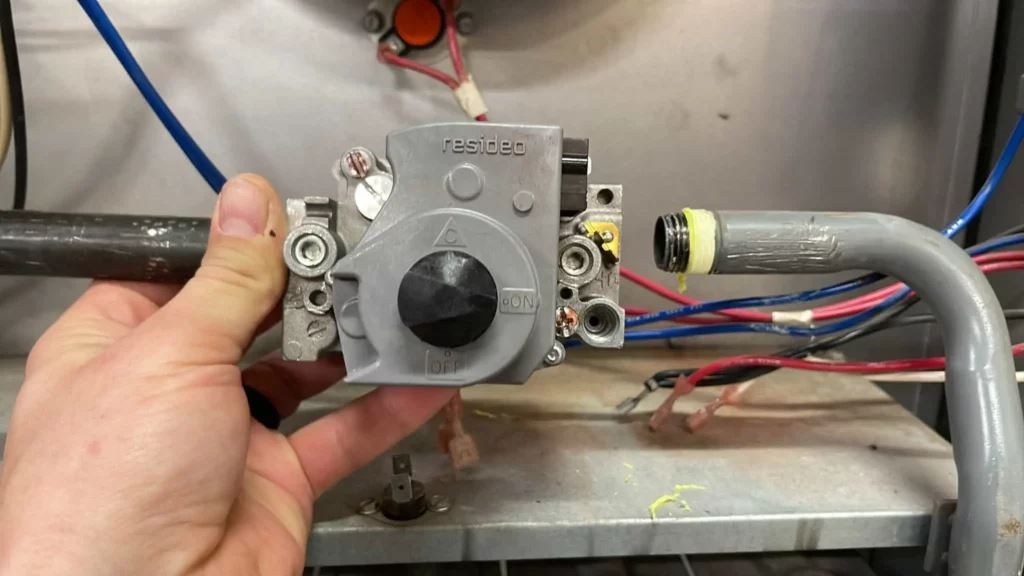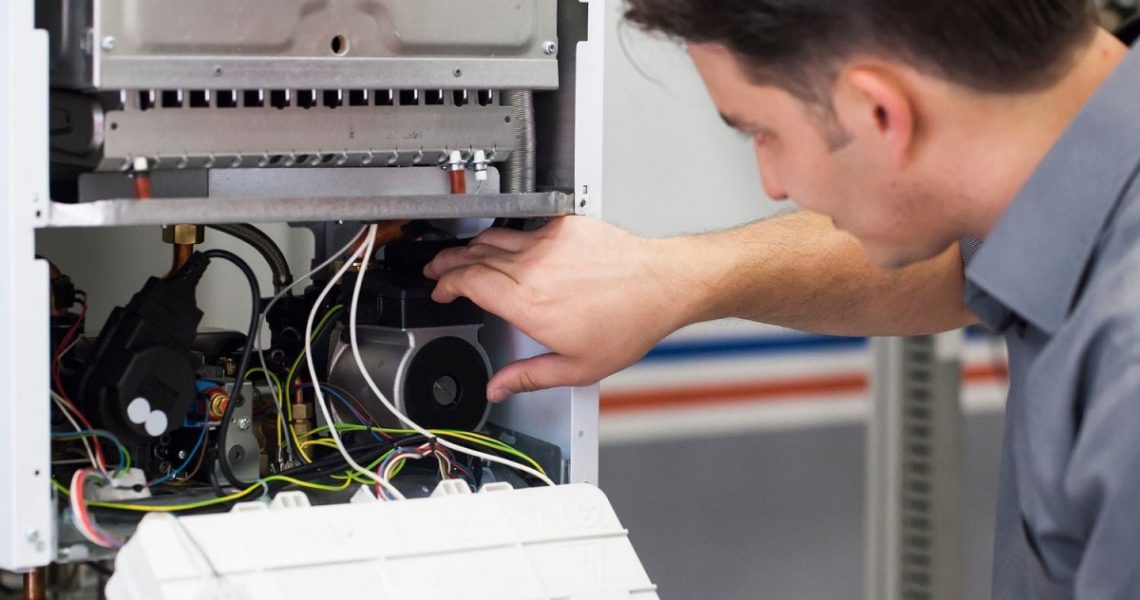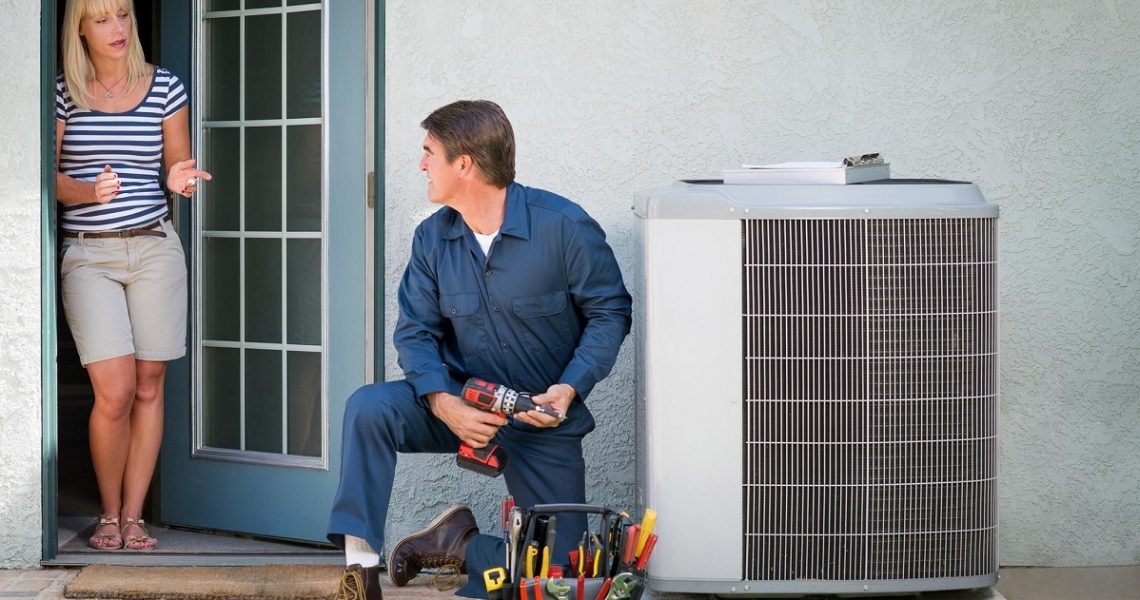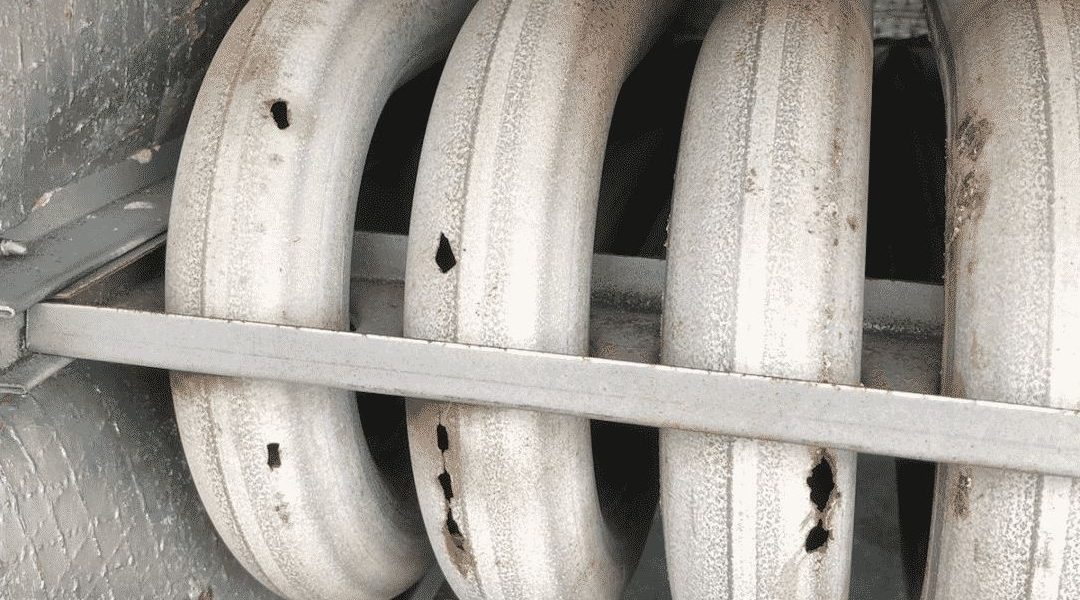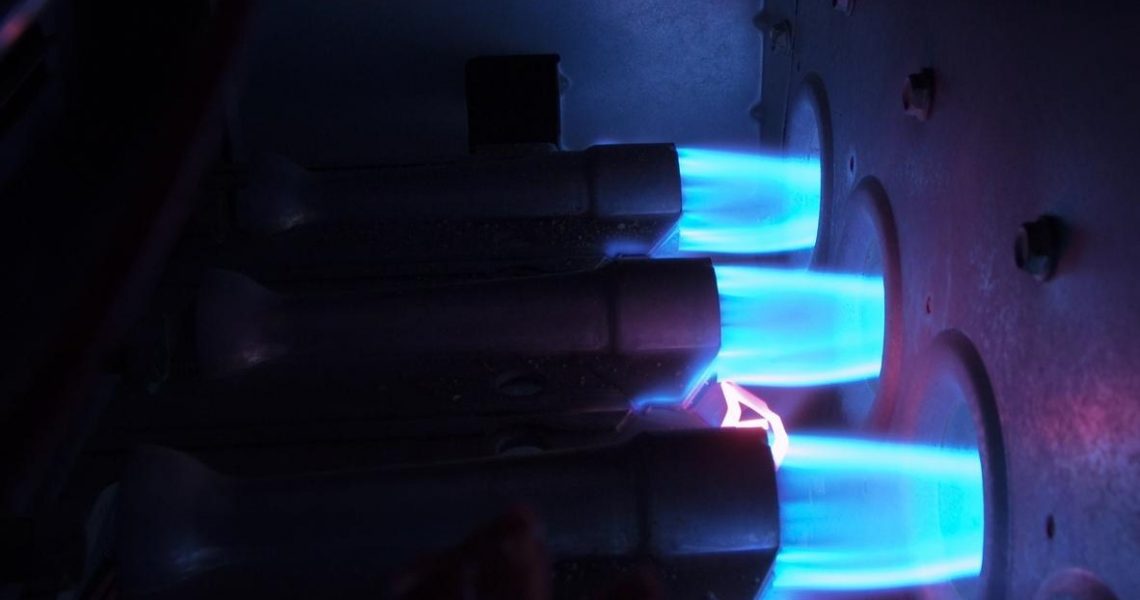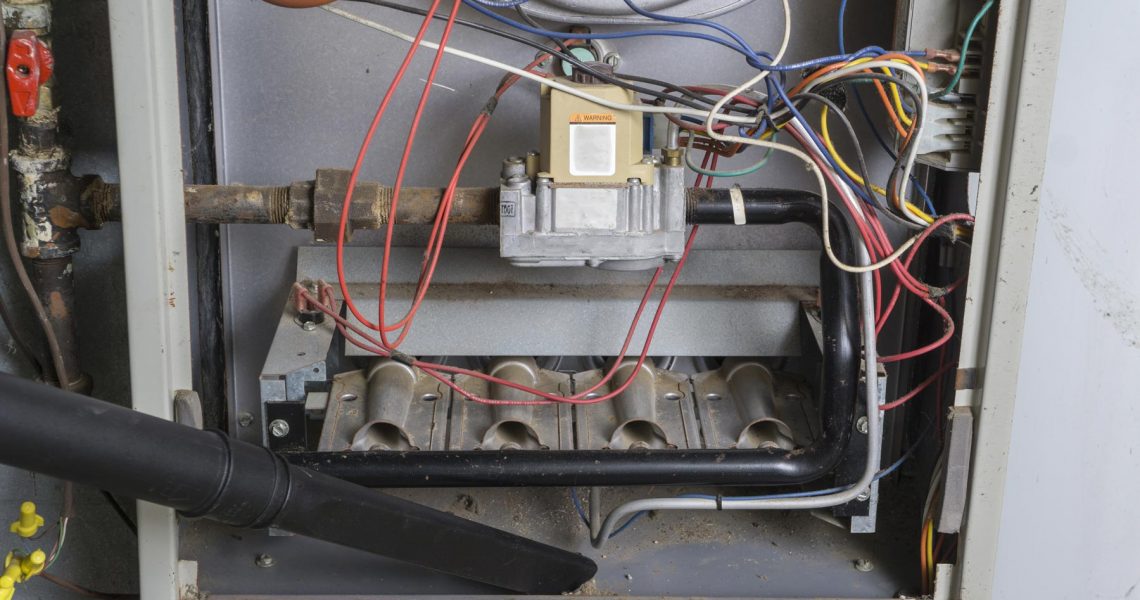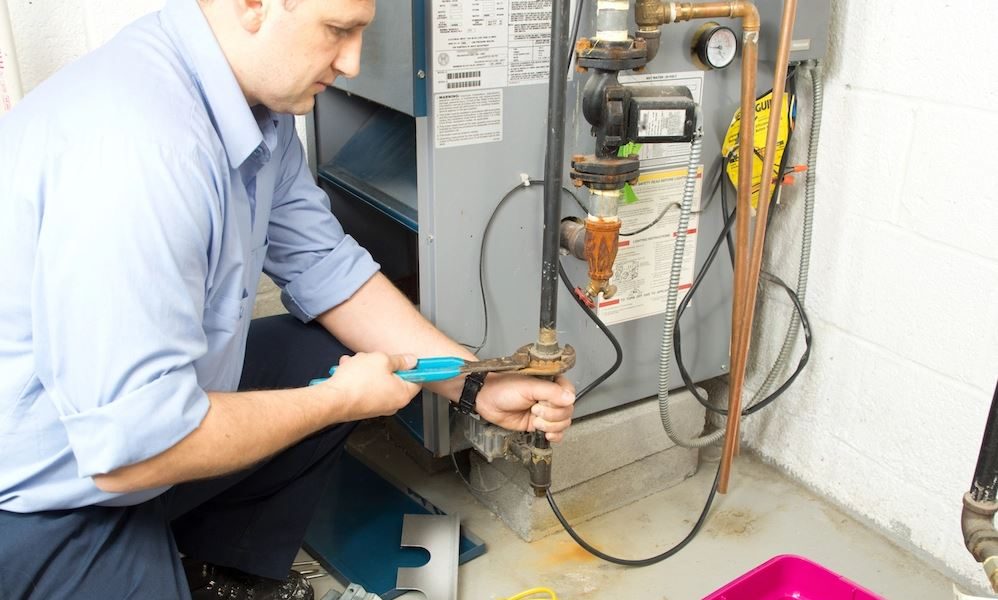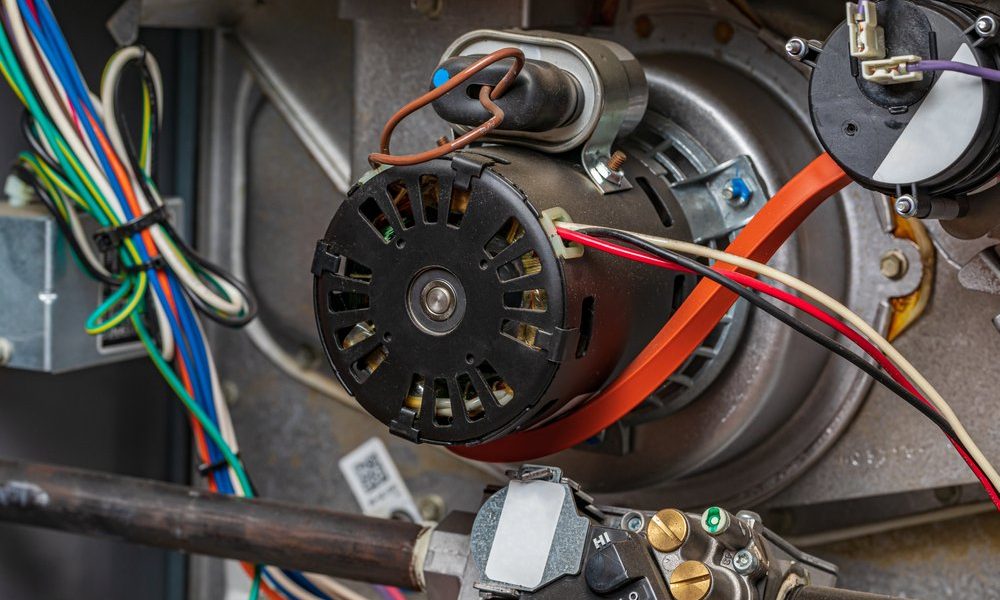3 Signs of a Faulty Furnace Gas Valve
A furnace gas valve allows natural gas or propane to flow into your unit. Occasionally these valves will stop opening and closing properly due to an obstruction, rust, or old age. If this valve malfunctions, it could be a hazard to your health and home as gas or propane will freely flow from the furnace without combustion.
Below are the 3 common signs of a faulty furnace gas valve to keep an eye out for as a faulty valve could be creating an unsafe environment. When in doubt, always call an HVAC professional.
FYI: When the valve stops working, it needs to be replaced as a repair is often more costly than a replacement. Typically, a gas valve replacement costs anywhere between $400 and $1000, making it one of the most expensive parts in a furnace to replace.
Gas leak
Sometimes a gas valve will get stuck open, allowing too much gas into your furnace while it is running, or allow gas to leak into your furnace while not running. Not only is this gas a fire hazard, but inhaling gas is very bad for your health. If you smell gas in your home, open your windows, exit your home, and call 911 immediately.
System failure
If your furnace is not heating your home or having trouble starting, this could mean your gas valve has malfunctioned and is not supplying enough—if any—gas to the unit. This means the ignitor will not work, your furnace will not be transferring any heat, and the system will stop blowing warm air. If the furnace is not running or it is not blowing warm air, call for a repair.
Though a system failure could be the result of a faulty furnace gas valve, there are many other possible culprits. If your unit is not blowing warm air, there are many other possible causes. Click here to learn more.
Furnace cycling
Similar to a system failure, when your furnace does not receive enough gas, it may continuously cycle to try to reach the temperature set on your thermostat. When the thermostat does not read the correct temperature, it will continue to tell the furnace to run. Regardless of the cause, a constantly cycling furnace could result in an overheated blower motor or other avoidable repair. If your furnace is cycling, shut the unit off and call for a repair.
In need of a furnace repair or inspection? Grand Home Services in Aurora, Colorado provides furnace inspections, repair, cleaning and replacement services throughout the Denver Metro Area. Whether it is an emergency or you need some guidance, do not hesitate to reach out to us! Contact us online or call us today.
What to Expect from a Furnace Tune-Up
We all know the importance of calling an HVAC technician when our furnaces stop working, but many of us don’t realize the importance of regular maintenance. Furnace tune-ups are not just about making sure things are running well. Tune-ups are all about inspecting, cleaning, repairs (if necessary), and ensuring your unit is running at peak efficiency. v Keep in mind, this is just scratching the surface! These are all common and typical, but depending on the age, manufacturer, and general state of your unit, additional items will need to be taken care of.
Clean blower compartment
This is one of the more important tasks taken care of during a furnace tune-up because blower motors and capacitors are one of the most expensive parts to replace. When the blower compartment goes uncleaned for many years, it must work harder to push warm air throughout your home which shortens its lifespan.
Inspect wiring
Inspecting the wiring ensures your furnace runs safely and prevents an untimely repair. If something goes wrong with the electrical, you may have to replace the circuit board, another very expensive part to replace.
Clean burner
Oftentimes the burner will get dirty from dust and debris, and as it burns natural gas, it will also burn everything around it. For safety, air quality and longevity, it is important the burner gets cleaned from time to time.
Inspect heat exchanger
The heat exchanger rarely needs much attention besides an inspection, but this inspection is a critical safety measure. If your heat exchanger is cracked or broken, carbon monoxide will leak into your unit and throughout your home.
Filter cleaning or replacement
Regularly changing or cleaning your furnace filter is absolutely necessary! A clean filter will keep all other parts in the furnace clean and running properly. This is something you can and should be doing as often as your manufacturer suggests, but an HVAC technician will take care of this for you during a furnace tune-up.
Pilot light inspection
Your pilot light indicates whether your furnace is receiving the right amount, too much, or too little natural gas, or there is something else burning altogether. The pilot light is a great way to tell if multiple parts within the furnace are doing their job.
Lubricate moving parts
Lubricating all the furnace’s moving parts will reduce friction. When there’s friction, the motor must work harder to reach your desired temperature, which requires more gas/electricity, and it could result in a premature failure.
Advice and tips
When you get a furnace tune-up, you may receive some advice on things you can maintain yourself, things you may need to do differently, and things you need to look out for. This advice is indispensable and will save you money in the long run.
Additional items taken care of during a tune-up include:
- Check duct connection and airflow
- Inspect the thermostat
- Inspect condensate line
- Test safety controls
- Inspect the belts
It might go without saying, but we believe tune-ups are very important! Are you in need of a furnace tune-up? Grand Home Services is located in Aurora and provides furnace tune-ups, repairs, and replacement services throughout the Denver Metro Area. Call us or contact us online today.
When to Get a Second Opinion for an HVAC Repair
Reputable HVAC professionals do their best to provide the most honest and trustworthy solutions, but there are some scenarios where having another company check your unit is always helpful and will give you peace of mind. You may even talk to two very reputable companies and one tells you your unit needs to be replaced while the other says you only need a repair. Every HVAC company runs a little differently, so second opinions are even more important in knowing what the problem is, if any, and knowing what your options are.
It can always feel a little awkward telling an HVAC technician you would like to get a second opinion, but most reliable HVAC companies will understand, and some even encourage them. Here are four common scenarios where you should consider getting a second opinion.
You’re getting a cleaning/tune-up and now a repair is “necessary”
Some unethical companies will offer very inexpensive tune-ups or very limited time specials just to get in the door. Once they are looking at your unit, they can say any part needs replacing. If it’s inexpensive and they can prove your unit needs a repair, a second opinion is not necessary. If it’s portrayed as an ‘urgent’ repair and it’s very expensive, it might be worth getting a second opinion.
The repair or replacement cost is shockingly high
When you are told a repair will be extremely expensive, it is always best to get a second opinion. This could be an unnecessary repair, price gouging, or simply an expensive part that really does need replacing. It’s always best to get a second opinion so you can ensure this repair is necessary and really is this expensive. Worst case, you get a similar or more expensive estimate from another company, but now you know the repair really is necessary. You may even get a cheaper estimate from another company.
Take a look at the 4 most expensive furnace repairs and 4 most expensive AC repairs. With all these repairs, you can expect a high repair estimate.
Your unit is fairly new and the cost to repair is high
The most expensive furnace and AC repairs are common among older units and very uncommon among new units. If your unit is new and you are told your unit needs a very expensive repair, always get a second opinion. Depending on the age of the unit, you may be under warranty.
You’ve never noticed an issue
When an expensive HVAC part needs to be repaired or replaced, chances are you have seen, heard, or even smelled a sign that something is wrong. If you are told something needs to be repaired and it is expensive and urgent, we recommend getting a second opinion. Though furnaces and AC units are complex and there are a lot of moving parts, when something malfunctions, there is usually a sign.
When in doubt, get a second opinion! You could save yourself hundreds of dollars, and you may even save yourself from a scam. If you are still unsure, do a little research online. There are plenty of resources available online that will give you typical repair and replacement costs.
In need of a second opinion in the Denver Metro Area? Grand Home Services is located in Aurora and we’d be happy to provide a second opinion. Unfortunately, HVAC scams are quite common, and we see and hear about them all the time. Please do not hesitate to call us, contact us online, or call another professional HVAC company to get a second opinion.
Your furnace’s heat exchanger is not easily accessible, it cannot be repaired, it is an expensive part to replace and oftentimes requires an entire furnace replacement, so this is a popular scam among dishonest HVAC technicians. Below is more information about heat exchangers, how they become cracked, and the signs of a cracked heat exchanger.
If you are told your heat exchanger is cracked, we always recommend getting a second opinion from another company!
What is a heat exchanger?
The heat exchanger is a thin metal piece between the combustion chamber and the blower. As the combustion chamber heats the exchanger, air is blown across the surface which heats the air. The warm air is then sent through your home’s ductwork to warm your home.
How does a heat exchanger crack?
Metal expands when it heats up and contracts when it cools down. Over time, this makes the metal more fragile which could lead to the metal cracking or breaking. The heat exchanger will typically last 15 years or more, but if your furnace is very old or poorly maintained, the chances of the heat exchanger cracking is higher than normal.
What are the signs of a cracked heat exchanger?
When the heat exchanger cracks, the most common problem is carbon monoxide leaking into your unit and throughout your home. You should have carbon monoxide detectors that will tell you if there is a leak, but if the leak is very small, you may notice your pilot light is discolored. Other signs include excess condensation coming from your unit, a strong odor, or a buildup of discolored soot.
Am I getting scammed?
If your furnace is fairly new and an HVAC technician tells you your furnace’s heat exchanger is cracked and the unit is no longer under warranty, this may be a scam. If your furnace is over 10 years old, it is a bit more likely that your heat exchanger is cracked. We always recommend keeping an eye out for the signs above and getting second opinion, regardless of the age of your unit.
If you are in the Denver Metro Area and think your heat exchanger is cracked or need a second opinion, give Grand Home Services a call today. We are located in Aurora and provide HVAC services throughout the metro area. We will never pressure you to fix a repair or replace your unit! Call us or contact us online today.
What the Color of Your Furnace Pilot Light Means
Your pilot light provides a small flame that remains lit inside your furnace to light the gas coming out of the main burner. This pilot light will indicate whether your furnace is receiving the right amount, too much, or too little natural gas, or there is something else burning altogether. Here are the typical colors of a furnace pilot light and what they each mean. When in doubt, call a professional!
Blue = Normal
When your pilot receives the correct amount of natural gas, the flame will be a bright blue color. The largest component of natural gas is methane which burns blue. The tip of the flame may appear orange or yellow, but this is normal. It’s best to check your pilot light from time to time and make sure it remains blue.
Flickering Yellow = Too Much Air
If your pilot light is flickering yellow, there is too much air in the gas line. This could be caused by a damaged tube or loose connection which is allowing air into the gas line, or the furnace’s thermocouple could be damaged. The thermocouple is responsible for opening and closing the main gas line and regulating the amount of gas feeding into the pilot. If it is not letting in enough gas, the flame may burn yellow. Because the two likely culprits that are letting in too much air could also be leaking gas, we recommend shutting off the furnace and calling for a repair.
Bright Orange = Too Much Gas
A bright orange pilot light is the most dangerous colored pilot light. When the flame is burning orange, this means too much gas is feeding the flame. If there is a gas leak from a damaged gas line or damaged thermocouple, the pilot light will not be able to fully burn all the gas and the flame will be orange.
Too much gas going into your furnace could pose a serious health risk by allowing gas to leak into your home through the vents. You will first smell the gas near your furnace and eventually throughout your home. The excess burn-off of the gas can also lead to a buildup of carbon monoxide. If you see a bright orange pilot flame, contact an HVAC contractor immediately.
Any other color?
If your pilot light is any other color like red, green, or some other combination, that means something other than methane—such as tar, oil, rust flakes, or dust—is burning. This could mean harmful chemicals are being pumped into your home along with the warm air your furnace is creating. You will need to shut off the furnace from the breaker box, shut the gas line, and call a professional for a repair.
If you think your pilot light is discolored or you have a question, it is always best to heir on the safe side and call an HVAC professional. Grand Home Services is located in Aurora, Colorado, and provides furnace repair, cleaning, and replacement services throughout the Denver Metro Area. Call us or contact us online today!
Gas furnaces run for months at a time, and they need regular cleaning and maintenance to provide reliable heating for your home. Hiring a professional for a furnace tune-up and cleaning is a great way to take care of your furnace before the winter season. A professional furnace cleaning ensures your furnace runs efficiently, reduces the chance of an emergency repair, and extends the lifespan of the unit.
The average cost of a professional furnace tune-up is between $100 and $200. The final cost will depend on the size of your furnace, fuel type, age, and level of service required. Click here to see what you can expect from a furnace tune-up.
We highly recommend hiring a professional to clean your furnace, but if you are in a pinch or would like to clean your furnace in between professional tune-ups, here’s how. If this is your first time cleaning your furnace, we strongly recommend consulting with a professional!
Note: Before you start taking your furnace apart, always make sure you shut the power off from the breaker box and shut the gas valve.
Replace the Filter
The simplest way you can—and should—prepare your furnace for the winter season is by replacing the filter. A dirty filter will inhibit airflow making your unit work harder to heat your home. A dirty filter will also not clean the air properly, creating dust and debris buildup and increasing your chances of needing a repair.
Clean the Blower Unit
This is one of the more complicated parts to clean in a furnace, and we strongly recommend leaving this to a professional. The blower motor has counterweights and wiring that are easy to disturb and this is one of the more expensive pieces to replace.
To clean the blower unit yourself, remove the control panel if it is in the way, then carefully remove the blower unit. Gently vacuum all dust and debris and use a small stiff brush to remove tough deposits of dirt. It’s important to clean the blower unit slowly and evenly.
Clean the Pilot or Igniter
Using compressed air or a drinking straw, carefully blow any dust off the pilot. If you have a newer furnace, you may have a hot surface igniter. Use condensed air or a straw to remove any dust, but do not touch this part as it is very fragile.
Clean the Flame Sensor
A furnace flame sensor is very important for safe operation of your furnace. The flame sensor detects the presence of a flame when the gas is on, then shuts down the system if no flame is detected.
Located on the burner assembly, it looks like a metallic rod. The flame sensor can be pulled down and out of the bracket gently for cleaning. Take an emery cloth and gently clean the surface of the flame sensor. Then slide the part back into place.
When you get a tune-up and cleaning from a professional, they will also check for any necessary repairs. This will reduce the chances of you needing an emergency furnace repair and ensure your furnace is running at peak performance.
In need of a furnace tune-up and cleaning in the Denver Metro Area? Grand Home Services is located in Aurora, Colorado and provides HVAC services throughout Denver. Call or contact us online today!
4 Furnace Noises and What They Mean
There are a number of furnace noises that are normal, especially when the furnace is just starting up. But, if the noises are excessive, loud, or out of the ordinary, we recommend shutting off the unit and calling a professional. Here are 4 common yet problematic furnace noises and what they typically mean.
1. Loud bang or boom
A loud bang or boom should never be coming from your furnace. This sound may be caused by your furnace having trouble igniting, creating a gas buildup in the combustion chamber which causes a small gas explosion when the furnace finally ignites. A gas burner that is having trouble igniting is an indicator of a clog, gas pressure problem, or a very dirty furnace. This is not something you should try fixing yourself. If you hear this noise, shut off your furnace and contact a licensed technician.
2. High-pitched squealing
If your furnace is making a high-pitched squealing noise, this is usually an indicator of a worn-out blower motor bearing. The bearings wear out from continuous friction from the blower motor during operation. High-pitched squealing can also be caused by insufficient lubrication or a damaged belt. Compared to other furnace repairs, these repairs are pretty minor and inexpensive, but if you are not familiar with the tools or equipment, call a professional.
3. Rattling or rumbling
A loose or broken part inside of your furnace will create a rumble or rattle. As this broken or loose part bangs into other components inside the furnace, it will cause more damage and require additional repairs. Be sure the cause is not as simple as a loose door cover, and if not, shut the system off and call for a furnace repair. Even if you know how to replace the broken part, it is best to get a full unit inspection.
4. Whistling
When your filter is dirty and the airflow running through your furnace is restricted, the air may make a whistling sound as it passes through the narrow openings. This not only creates an annoying sound, but your furnace must work much harder to reach your desired temperature. You’ll be paying a higher-than-necessary utility bill and you are shortening the lifespan of your unit. Always be sure to replace the filter as often as the furnace manufacturer recommends.
Loud or odd noises coming from your furnace are rarely a good thing. It’s always best to heir on the safe side and talk to a professional HVAC specialist. Grand Home Services in Aurora, Colorado provides furnace inspections, repair, cleaning and replacement services throughout the Denver Metro Area. Whether it is an emergency or you need some guidance, do not hesitate to reach out to us! Contact us online or call us today.
My Furnace is Running but Not Heating
Is your furnace running but not creating warm air and heating your home? If so, below is a list of possible culprits that you can check yourself before calling an HVAC technician. Some of these you can fix yourself, others you will need to consult a professional.
Check the Thermostat
It might seem too simple, but if your furnace is not creating heat, always start with checking the thermostat. The batteries might be dead or an adjustment could have been made without you knowing and the fix is as quick as a setting change.
Check the Filter
A dirty filter can wreak havoc on your furnace. Not only will it obstruct airflow, but it will not clean the air before it runs through the unit and inhibit the unit from doing its only job. If your filter is dirty, replace it or clean it and test your furnace.
Inspect the Pilot Light
Gas furnaces rely on a standing pilot light to operate. If the pilot light somehow goes out, the fan may run but the furnace will not warm the air. If you don’t see a blue flame near the bottom of your furnace, you will need to access the reset switch and use a lighter to light the pilot again. If this happens multiple times, you should call an HVAC pro.
Check the Condensate Line
High-efficiency or condensing furnaces produce condensation during combustion. This excess moisture falls onto a drip pan and is drained outside of the home through a condensate line. These condensate lines can become clogged with dirt and grime, especially if you do not keep up with furnace maintenance and filter changes. If the line becomes blocked, the water will end up back in the furnace, which will trip the overflow kill switch and shut down your furnace. Your furnace will either not turn on or simply blow cold air.
Inspect the Burners
The burners on gas furnaces are responsible for delivering and adjusting the flow of gas to keep it lit when running. If your furnace has not been cleaned in a while, dirt and debris can collect on the burners, preventing your furnace from getting enough gas to burn and warm the air. This is a fairly simple repair, but always consult a professional if you are not familiar with the equipment.
In many cases, cold air blowing through your vents is an easy problem to fix that you can do yourself. If you cannot figure out why your furnace is running but not heating the air, it is time to call an HVAC expert to diagnose your furnace.
In need of a furnace diagnosis, cleaning, repair or replacement? Grand Home Services in Aurora provides all these services and more throughout the Denver Metro Area. Call us or contact us online today!
When to Call for an Emergency Furnace Repair
Furnaces are complex systems that need repairs and tune-ups from time to time, but every so often the unit needs immediate attention. When there is an issue with your furnace, it can be stressful trying to figure out if this is something you can fix yourself, something only a professional can handle, or—worst-case scenario—an emergency.
Below are some common situations in which you should call for an emergency furnace repair. When in doubt, always call an HVAC specialist.
Your Furnace Won’t Turn On or Blows Cold Air
Complete furnace breakdowns occur when you cannot get your unit to turn on or blow warm air. If your furnace isn’t working, you should immediately check your circuit breaker and your thermostat. If your unit is receiving power and the thermostat is set higher than the ambient temperature of your home, it’s a situation where you should call for an emergency furnace repair. The longer you wait, the more uncomfortable your home will become, especially here in Aurora, Colorado where we reach below freezing.
Unusual Noises
If your furnace is making unusual noises, especially loud noises, shut the unit off immediately and call for an emergency repair. Unusual noises typically mean a part is loose or broken and needs to be replaced. Letting the furnace run with a broken part could cause much more damage and a much higher repair bill.
Gas or Carbon Monoxide Leak
If you smell gas or your carbon monoxide detectors are going off, this is an emergency that needs to be taken care of immediately. This is not something you should take care of yourself. Call the fire department to come take care of the problem.
Another indication of a carbon monoxide leak is a yellow flame in your furnace (the flame should be blue). A yellow flame does not always mean a carbon monoxide leak, but it is still a reason to shut off the unit and call for an emergency furnace repair.
Electrical Issues
If you suspect an electrical problem, you should not wait to call a professional. Some common signs of a furnace electrical problem are a tripped breaker, a buzzing or humming sound, or a flickering/dim pilot light. Electrical issues are very serious and not something you should attempt to take care of yourself. There is a risk of a serious home electrical issue like a blackout or fire. An HVAC contractor has the experience and the technical knowledge needed to identify and fix the problem.
If you are near Grand Home Services in Aurora, please give us a call. We offer 24/7 furnace emergency repair services throughout Aurora and the Denver Metro Area.
Cost to Replace a Furnace Blower Motor in Denver
Replacing a failed blower motor is a major furnace repair and is one of the more expensive repairs homeowners face as their furnace gets older. Below we break down the average cost to replace a furnace blower motor for a Denver homeowner and why the price varies furnace-to-furnace, company-to-company.
Cost to Replace Blower Motor in Denver
The cost to replace your blower motor depends on whether your blower motor is variable-speed or single-speed, the brand of your furnace, and the repair company you hire to handle the repair for you. Unless you have a warranty for your unit, you can expect to pay anywhere from $1,000 to as much as $1,600 for a furnace blower motor replacement.
If a company tries to charge you less, they aren’t giving you all the benefits you get with the top companies in town. When you replace the blower motor in your furnace, the HVAC technician should replace the capacitor as well. A company that quotes $750 may not be including the additional $300 – $400 for the capacitor that needs to be replaced as well. Always make sure you get the complete quote upfront so you don’t get hit with an unexpected charge. As always, we recommend Denver homeowners work with an established HVAC company to ensure an honest and reliable repair.
National Replacement Averages
Larger websites like HomeAdvisor will give low quotes to pique your interest and give some business to the companies that use their site. These prices are very generic, typically don’t include every single charge that would come with a repair and are not based on your specific city. From the quality of the technician to the quality of service, paying more than these low national averages is for good reason. Long story short, you will not find a successful and reputable HVAC company charge these low prices.
Just Hire the Good Guys
When you find yourself getting quotes from several companies for a blower motor replacement, always ask if the estimate includes a capacitor replacement. If a company is unable to share a quote over the phone, not to worry, they may need to see the furnace in-person. Just make sure to get the full quote before they go to work.
Furnace Blower Motor Replacement in Denver
In need of a furnace blower motor replacement in the Denver Metro Area? Grand Home Services would be happy to help. Call us or contact us online if you need more information or would like to get started!

